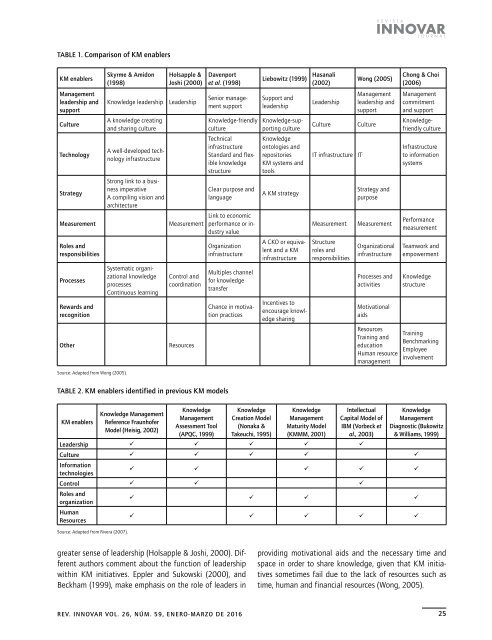Enero-marzo
v26n59
v26n59
Create successful ePaper yourself
Turn your PDF publications into a flip-book with our unique Google optimized e-Paper software.
REVISTA<br />
INNOVAR<br />
JOURNAL<br />
TABLE 1. Comparison of KM enablers<br />
KM enablers<br />
Management<br />
leadership and<br />
support<br />
Culture<br />
Technology<br />
Strategy<br />
Measurement<br />
Roles and<br />
responsibilities<br />
Processes<br />
Rewards and<br />
recognition<br />
Skyrme & Amidon<br />
(1998)<br />
Knowledge leadership<br />
A knowledge creating<br />
and sharing culture<br />
A well-developed technology<br />
infrastructure<br />
Strong link to a business<br />
imperative<br />
A compiling vision and<br />
architecture<br />
Systematic organizational<br />
knowledge<br />
processes<br />
Continuous learning<br />
Holsapple &<br />
Joshi (2000)<br />
Leadership<br />
Measurement<br />
Control and<br />
coordination<br />
Other Resources<br />
Davenport<br />
et al. (1998)<br />
Senior management<br />
support<br />
Knowledge-friendly<br />
culture<br />
Technical<br />
infrastructure<br />
Standard and flexible<br />
knowledge<br />
structure<br />
Clear purpose and<br />
language<br />
Link to economic<br />
performance or industry<br />
value<br />
Organization<br />
infrastructure<br />
Multiples channel<br />
for knowledge<br />
transfer<br />
Chance in motivation<br />
practices<br />
Liebowitz (1999)<br />
Support and<br />
leadership<br />
Knowledge-supporting<br />
culture<br />
Knowledge<br />
ontologies and<br />
repositories<br />
KM systems and<br />
tools<br />
A KM strategy<br />
A CKO or equivalent<br />
and a KM<br />
infrastructure<br />
Incentives to<br />
encourage knowledge<br />
sharing<br />
Hasanali<br />
(2002)<br />
Leadership<br />
Culture<br />
IT infrastructure IT<br />
Measurement<br />
Structure<br />
roles and<br />
responsibilities<br />
Wong (2005)<br />
Management<br />
leadership and<br />
support<br />
Culture<br />
Strategy and<br />
purpose<br />
Measurement<br />
Organizational<br />
infrastructure<br />
Processes and<br />
activities<br />
Motivational<br />
aids<br />
Resources<br />
Training and<br />
education<br />
Human resource<br />
management<br />
Chong & Choi<br />
(2006)<br />
Management<br />
commitment<br />
and support<br />
Knowledgefriendly<br />
culture<br />
Infrastructure<br />
to information<br />
systems<br />
Performance<br />
measurement<br />
Teamwork and<br />
empowerment<br />
Knowledge<br />
structure<br />
Training<br />
Benchmarking<br />
Employee<br />
involvement<br />
Source: Adapted from Wong (2005).<br />
TABLE 2. KM enablers identified in previous KM models<br />
KM enablers<br />
Knowledge Management<br />
Reference Fraunhofer<br />
Model (Heisig, 2002)<br />
Knowledge<br />
Management<br />
Assessment Tool<br />
(APQC, 1999)<br />
Knowledge<br />
Creation Model<br />
(Nonaka &<br />
Takeuchi, 1995)<br />
Knowledge<br />
Management<br />
Maturity Model<br />
(KMMM, 2001)<br />
Intellectual<br />
Capital Model of<br />
IBM (Vorbeck et<br />
al., 2003)<br />
Leadership ü ü ü ü ü<br />
Knowledge<br />
Management<br />
Diagnostic (Bukowitz<br />
& Williams, 1999)<br />
Culture ü ü ü ü ü<br />
Information<br />
technologies<br />
ü ü ü ü ü<br />
Control ü ü ü<br />
Roles and<br />
organization<br />
Human<br />
Resources<br />
Source: Adapted from Rivera (2007).<br />
ü ü ü ü<br />
ü ü ü ü ü<br />
greater sense of leadership (Holsapple & Joshi, 2000). Different<br />
authors comment about the function of leadership<br />
within KM initiatives. Eppler and Sukowski (2000), and<br />
Beckham (1999), make emphasis on the role of leaders in<br />
providing motivational aids and the necessary time and<br />
space in order to share knowledge, given that KM initiatives<br />
sometimes fail due to the lack of resources such as<br />
time, human and financial resources (Wong, 2005).<br />
REV. INNOVAR VOL. 26, NÚM. 59, ENERO-MARZO DE 2016<br />
25


